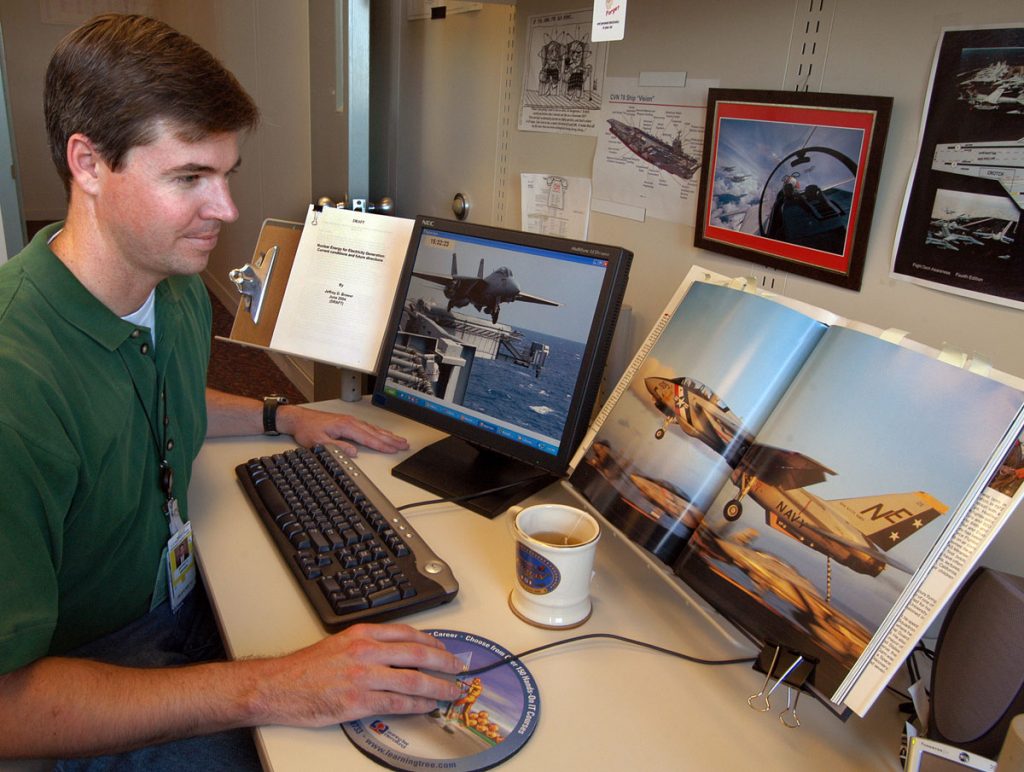
Download 300dpi JPEG image, ‘system-review.jpg’, 272K (Media are welcome to download/publish this image with related news stories.)
ALBUQUERQUE, N.M. — Researchers at the National Nuclear Security Administration’s Sandia National Laboratories are helping the U.S. Navy create the next generation of aircraft carriers by reviewing and analyzing current Carrier Air Wing flight operations, maintenance, and support functions.
The primary goal of Sandia’s project is to assist the Navy in achieving manpower reductions of at least 10 to 30 percent while increasing the amount of technology on board an aircraft carrier to reduce the overall workload per sailor.
“We will be probing each of these areas to find ways to maintain or improve airwing performance while reducing personnel and making the remaining jobs more desirable,” said Jeff Brewer, Sandia engineer and project principal investigator. “This will be done while simultaneously improving the airwing staffing decision-making process.”
The first phase of the project is a four-month evaluation of current Navy air wing operations, structure, and improvement alternatives. The second is a six-month phase in which Sandia will conduct an in-depth analysis of the alternatives established during the evaluation.
Sandia is assisting with the Navy’s CVN 21 program that is being carried out to develop the next-generation aircraft carrier. The actual carrier that will result in 2013 or 2014 will be designated as the CVN 78, the Navy’s 78th aircraft carrier.
“The idea is not to simply have fewer people on board who work harder than previous crews,” said Brewer, “but to enable organizational changes, technology improvements, and work practice changes to achieve the desired operational capability of the airwing and make jobs more desirable for the personnel in the system.”
Approach
The Sandia team will be reviewing Navy documentation for aircraft currently in use and those anticipated to be in service in 2020.
The team will discuss how flight operations, maintenance, and other support operations are performed both in the Atlantic and Pacific fleets. Brewer said there are differences between documented procedures and actual practice revealed by subject matter experts within the two fleets.
Sandia will work with various Navy teams that have developed computational models of how these operations are currently performed. The team will work with the designers of the new aircraft carrier to generate substantial changes that may improve flight operations and support functions.
In-depth analysis
Items of particular interest include the definitions and scope of the tasks and functions performed within individual jobs, and staffing levels for various types of jobs and tasks. This includes formal schooling, on-the-job training, self-study, testing of skills involved to prepare people for those jobs, and the tools and techniques used to execute these tasks.
Brewer said the actual execution methods for flight operations, support jobs, and the design of the spaces aboard current aircraft carriers where these tasks are performed will be analyzed. This knowledge will be combined with the designs envisioned for the next-generation aircraft carrier. The complexity of carrier flight operations and the associated support functions require an unusually high level of system understanding and computational modeling to achieve optimal combinations of personnel, equipment, and procedures.
“The concept of operations under which an aircraft carrier is asked to function can change rapidly,” Brewer said. “There currently isn’t a detailed, rapid, and robust analytical tool for probing this particular complex system.”
System of systems
Creating a “system of systems” analysis capability that enables greater quantitative understanding of the aircraft carrier environment is key to the project, said Brewer.
System of systems refers to a collection of systems that result in emergent behaviors that cannot be explained by individual system analysis. This includes monitoring system performance at a sufficient level of detail and enabling rapid “what if” or tradeoff analyses to aid in decision making by Navy leaders.
In this project, building a comprehensive system of systems capability to monitor and analyze carrier air wing operations may involve linking a number of computer models that have been developed independently. In addition, new models may be built where necessary, and merged into a computational architecture that becomes a system-wide metric-based computational engine including a mix of discrete-event simulation and optimization algorithms.
“The hope is that we will be able to utilize a number of the modeling and simulation technologies developed for other major programs such as the Army’s Future Combat System and Lockheed Martin’s Joint Strike Fighter program,” said Robert Cranwell, Sandia engineer and project manager for the Navy Manpower Study program. “Use of these technologies has proven to be very successful in supporting these programs.”
The Army has incorporated a number of these technologies as part of its Test and Evaluation Center capabilities, he said.
Several Sandians recently visited the USS Harry S. Truman and received a brief introduction to flight operations, aircraft maintenance operations, and flight operation planning techniques. An extended visit to the USS Nimitz was planned for mid-to-late-August.